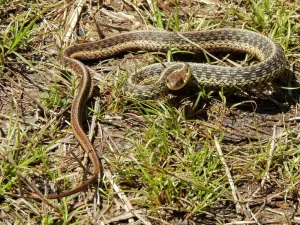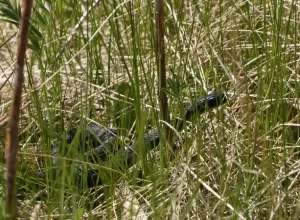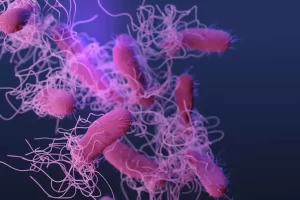Garter snakes are medium-sized snakes easily recognizable by the distinctive stripes running lengthwise along their scales. However, some individuals lack stripes.
If a garter snake is threatened by a predator, it will release a foul-smelling, greasy fluid, called ‘musk’, from glands located near the base of the tail. This fluid not only smells bad but is also distasteful to many predators.
In addition to musk, garter snakes also often defecate when threatened. Musk, combined with fecal matter, can create a very pungent smell, that is extremely unpleasant to many predators.
Releasing this foul-smelling secretion makes garter snakes a less appealing meal for many would-be predators, increasing their chance of survival.
Garter Snakes Do Not Constantly Smell Bad
In general, garter snakes are not any more smelly than the average snake.
The unpleasant smell often associated with garter snakes snakes only happens when these snakes feel threatened.
When grabbed by an attacker, garter snakes will discharge fluid from glands near the cloaca. As earlier mentioned, this secretion is called ‘musk’; and has a strong, foul smell – that is sometimes compared to the smell of rotting fish.
This musk is a yellowish, oily liquid, and is a complex mixture of organic chemicals, such as alcohols and acids.

In addition to musking, garter snakes will also often defecate on their attacker. The combination of musk and fecal matter can create a very repulsive smell.
Garter snakes can also smear the musk on themselves, and some even can spray their musk a short distance.
If you pick up a garter snake, you might get musked too! The snake will react in the same way it would react to a fox or any other predator in the wild.
That said, the musk is not poisonous, or harmful in any real way, so you should be fine after thoroughly washing your hands with anti-bacterial soap, under running water.
Why Do Garter Snakes Produce Musk?
Garter snakes are eaten by a wide variety of predators, such as crows, hawks, foxes, raccoons, and even larger snakes.
For this reason, these snakes developed several ways to defend themselves.
As a first line of defense, most garter snakes will remain motionless, and rely on their camouflage to blend into their environment. Their coloration makes them hard to see in grassy areas.

However, when they are spotted by a predator, these snakes will attempt to use their speed to flee. A garter snake on land may flee to the water to escape a land predator.
However, If cornered, a garter snake may hide its head, while waving its tail, or may even coil to make itself appear larger, and may strike and bite.
This is where musking also comes in.
When grabbed, garter snakes release their foul-smelling musk, and may also defecate on the attacker. The smell and taste of the musk, often combined with fecal matter, can make a predator gag, or even vomit, giving these snakes a chance to escape.
Some predators will learn to associate the bad smell with an unpleasant taste and may avoid attacking garter snakes in the future.
Garter snakes will typically only release their musk as a last line of defense against predators that have successfully captured them.
What to Do if a Garter Snake Musks You
If a garter ever sprays its musk on you, take the following precautions to protect both you and the animal.
1. Gently Put the Snake Down
If a garter snake musks you, it is a sign that the snake sees you as a harmful predator and feels stressed and uncomfortable.
Be mindful of the snake’s welfare and very gently place it down.
Avoid dropping the snake from a distance, as it could be harmed from a hard fall.
2. Very Thoroughly Wash Your Hands Under Running Water
After handling any reptiles, it is extremely important to thoroughly wash your hands with anti-bacterial soap, under running water.
Reptiles can carry salmonella and other germs that are harmful to humans.

Exposure to salmonella can lead to an illness known as salmonellosis which is characterized by diarrhea, fever, and abdominal cramps.
Fortunately, you won’t get sick by simply touching a reptile. The bacteria can only cause illness when they are ingested.
Therefore, thoroughly washing your hands with anti-bacterial soap immediately after touching any reptiles should keep you out of harm’s way.
Before washing your hands, do not touch anything (you could spread bacteria) – and do not rub your eyes, touch your face, or put anything into your mouth.
Many Snakes Use Musking as a Defense Mechanism
Garter snakes are not the only snakes that musk.
Other snake species, such as Rat Snakes, Milk snakes, Kingsnakes, and Corn snakes also musk to defend themselves from predators.
Apart from musking, these snakes also employ several other defensive tactics.
Snakes Do Not Like to Be Handled by Humans
Generally, snakes do not like to be handled by humans, or any other creature larger than them.
Handling a garter snake can cause the reptile a lot of stress, especially if the snake is restrained or being handled in a way that causes it discomfort.
Snakes are constantly threatened by predators, so even a human who means no harm will be perceived as a danger.
When you approach a garter snake, it will react in the same way it would react to a snake or any other predator in the wild.
It may coil, and release its musk, to make itself less appealing.
What Other Animals Use Odors to Defend Themselves?
Using a foul odor as a defense against predators is not uncommon in the animal kingdom
Here are a few other animals that produce a foul smell to deter predators.
1. Skunks
Skunks are the most well-known animals that use bad odors as a defense against predators.
When a skunk is approached by a predator, it can shoot out a foul-smelling spray from anal glands, located inside the rectum, and the base of the tail.
This spray is emitted as a stream, aimed at the predator’s face, and is accurate as far as 10 feet (3 meters)!
If the skunk is being chased, by a predator, it can shoot out its spray in a cloud, that the predator has to run through.
A skunk spray can cause serious irritation and even temporary blindness. It is powerful enough to ward off even large predators such as bears.
Despite their unique defense, skunks are still preyed on by the great horned owl (Bubo virginianus), which is their only regular predator.
2. Opossums
Opossums are fairly slow-moving creatures and are preyed on by foxes, snakes, and many predatory birds.
However, these animals are not completely defenseless.
When approached by a predator on land, these animals may play dead, with their tongues hanging out. A foul-smelling fluid is also secreted from the anal glands, which mimics the smell of a dead animal.
Taking on the appearance and smell of a dead animal increases Opossums’ chances of survival. Many predators are discouraged from eating them – and instead, look for a fresher meal elsewhere.
3. Stinkbugs
‘Stinkbug’ can refer to any of about 5,000 insect species in the family Pentatomidae.
These insects get their name from the foul-smelling secretions they produce to deter predators.
When threatened or crushed, stinkbugs release a pungent spray, generally composed of aldehydes and alkanes.
The smell of the spray can transfer to the resting place of the insect, such as leaves, or fruits, giving them a nauseating taste.
Interestingly, stinkbugs are not the only insects with chemical defenses. For example, beetles in the genus Eleodes, exude a foul-smelling odor and and a very distasteful liquid to ward off predators.
4. Sea Hares
Using foul-smelling odors as a defense against predators is not only limited to terrestrial animals.
Sea hares are marine snails found in shallow water.
When threatened, these mollusks can release a white, purple, or red ink, which dyes the surrounding water and affects its predator’s olfactory senses ( the sense of smell).
This secretion is very unpleasant to many predators and makes sea hares a less appealing meal.
In addition to the colored ink, sea hares can also secrete a clear slime, which physically plugs the olfactory receptors of some predators, such as lobsters.
Conclusion
Garter snakes do not always smell BAD. The unpleasant odor associated with these snakes is produced by a fluid known as musk.
Musk is secreted to make these snakes a less appealing meal to any predators that might want to prey on them.
When a pick up a garter snake, the animal may release its musk, which will create a very bad smell.
However, musk is not poisonous or harmful in any way, so you should be fine after very thoroughly washing your hands.
SOURCES:
Wood WF, Parker JM, Weldon PJ. Volatile components in scent gland secretions of garter snakes (Thamnophis spp.). J Chem Ecol. 1995 Feb;21(2):213-9. doi: 10.1007/BF02036652. PMID: 24234020.
Kissner, K. J., Blouin-Demers, G., & Weatherhead, P. J. (2000). Sexual Dimorphism in Malodorousness of Musk Secretions of Snakes. Journal of Herpetology, 34(3), 491–493. https://doi.org/10.2307/1565381
Wood, William. (1999). The History of Skunk Defensive Secretion Research. The Chemical Educator. 4. 44-50. 10.1007/s00897990286a.
Stink Bugs – USDA Agricultural Research Service
Tiffany Love-Chezem, Juan F. Aggio, Charles D. Derby; Defense through sensory inactivation: sea hare ink reduces sensory and motor responses of spiny lobsters to food odors. J Exp Biol 15 April 2013; 216 (8): 1364–1372. doi: https://doi.org/10.1242/jeb.081828
Hi, my name is Ezra Mushala, i have been interested animals all my life. I am the main author and editor here at snakeinformer.com.

